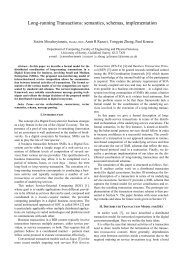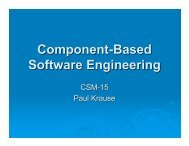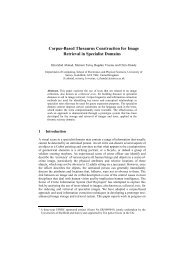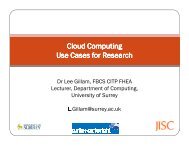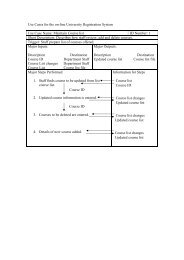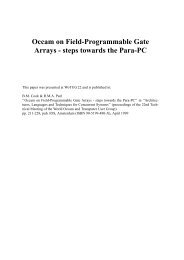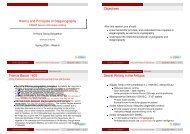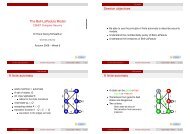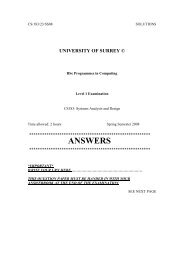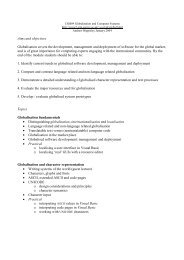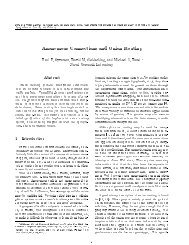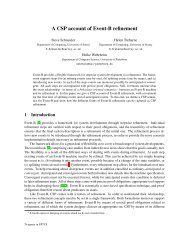The DCT domain and JPEG - University of Surrey
The DCT domain and JPEG - University of Surrey
The DCT domain and JPEG - University of Surrey
You also want an ePaper? Increase the reach of your titles
YUMPU automatically turns print PDFs into web optimized ePapers that Google loves.
Learning Objectives<br />
<strong>The</strong> <strong>DCT</strong> <strong>domain</strong> <strong>and</strong> <strong>JPEG</strong><br />
CSM25 Secure Information Hiding<br />
Dr Hans Georg Schaathun<br />
<strong>University</strong> <strong>of</strong> <strong>Surrey</strong><br />
Be able to work with <strong>and</strong> <strong>JPEG</strong> images <strong>and</strong> other representations<br />
in the transform <strong>domain</strong>.<br />
Underst<strong>and</strong> what happens during <strong>JPEG</strong> compression, <strong>and</strong> its<br />
potential consequence to watermarking <strong>and</strong> steganography.<br />
Be able to apply simple LSB embedding in the <strong>JPEG</strong> <strong>domain</strong>.<br />
Spring 2009 – Week 3<br />
Dr Hans Georg Schaathun <strong>The</strong> <strong>DCT</strong> <strong>domain</strong> <strong>and</strong> <strong>JPEG</strong> Spring 2009 – Week 3 1 / 47<br />
Dr Hans Georg Schaathun <strong>The</strong> <strong>DCT</strong> <strong>domain</strong> <strong>and</strong> <strong>JPEG</strong> Spring 2009 – Week 3 2 / 47<br />
<strong>The</strong> elements <strong>of</strong> <strong>JPEG</strong><br />
Overview<br />
Overview<br />
<strong>JPEG</strong> is not a file format<br />
Operates on luminence <strong>and</strong> chrominance (YCbCr) (not on RGB)<br />
Grayscale images have luminence component only.<br />
Downsampling<br />
Works in the <strong>DCT</strong> <strong>domain</strong> (not the spatial <strong>domain</strong>)<br />
Quantisation<br />
Entropy coding (lossless compression)<br />
<strong>JPEG</strong> is a compression system<br />
<strong>The</strong> system employs three different compression techniques<br />
<strong>JPEG</strong> is not a file format.<br />
Files with extension .jpeg are <strong>of</strong>ten JFIF or EXIF.<br />
JFIF is traditionally the most common file format for <strong>JPEG</strong>.<br />
EXIF is made for digital cameras <strong>and</strong> contain extra meta<br />
information.<br />
Dr Hans Georg Schaathun <strong>The</strong> <strong>DCT</strong> <strong>domain</strong> <strong>and</strong> <strong>JPEG</strong> Spring 2009 – Week 3 4 / 47<br />
Dr Hans Georg Schaathun <strong>The</strong> <strong>DCT</strong> <strong>domain</strong> <strong>and</strong> <strong>JPEG</strong> Spring 2009 – Week 3 5 / 47
Reading<br />
Overview<br />
Image Representation<br />
Alternatives to RGB<br />
<strong>The</strong> RGB colour representations<br />
Core Reading<br />
Digital Image Processing Using MATLAB.<br />
Chapter 6: colour images<br />
Representation<br />
Processing<br />
Conversion<br />
Chapter 8.5: <strong>JPEG</strong> compression<br />
Chapter 4: Frequency <strong>domain</strong> processing<br />
RGB : A colour is a vector (R, G, B)<br />
R is amount <strong>of</strong> red light.<br />
G is amount <strong>of</strong> green light.<br />
B is amount <strong>of</strong> blue light.<br />
Each pixel can be either<br />
A colour vector (R, G, B); or<br />
a reference to an array <strong>of</strong> colour vectors (the palette)<br />
Each coefficient can be<br />
∈ [0, 1]; floating point (double in matlab)<br />
∈ {0, 1, . . . , 255}; 8-bit integer (uint8 in matlab)<br />
∈ {0, 1, . . . , 2 16 − 1}; 16-bit integer (uint16 in matlab)<br />
Dr Hans Georg Schaathun <strong>The</strong> <strong>DCT</strong> <strong>domain</strong> <strong>and</strong> <strong>JPEG</strong> Spring 2009 – Week 3 6 / 47<br />
Dr Hans Georg Schaathun <strong>The</strong> <strong>DCT</strong> <strong>domain</strong> <strong>and</strong> <strong>JPEG</strong> Spring 2009 – Week 3 8 / 47<br />
Image Representation<br />
Alternatives to RGB<br />
Image Representation<br />
<strong>The</strong> blockwise <strong>DCT</strong> <strong>domain</strong><br />
Alternatives to RGB<br />
Block-wise<br />
NTSC : (Y , I, Q)<br />
where R, G, B ∈ [0, 1].<br />
YCbCr : (Y , Cb, Cr)<br />
⎡ ⎤ ⎡<br />
⎤ ⎡ ⎤<br />
Y 0.299 0.587 0.114 R<br />
⎣ I ⎦ = ⎣0.596 −0.274 −0.322⎦<br />
⎣G⎦<br />
Q 0.211 −0.523 0.312 B<br />
⎡ ⎤ ⎡ ⎤ ⎡<br />
⎤ ⎡ ⎤<br />
Y 16 65.481 128.553 24.966 R<br />
⎣Cb⎦ = ⎣128⎦ + ⎣−37.797 −74.203 112.000⎦<br />
⎣G⎦<br />
Cr 128 112.000 −93.786 −18.214 B<br />
Each colour-channel (Y,Cb,Cr) considered separately<br />
M × N matrix divided into 8 × 8 blocks<br />
Each block is h<strong>and</strong>led separately<br />
where R, G, B ∈ [0, 1] <strong>and</strong> Y , Cb, Cr ∈ [0, 255].<br />
Dr Hans Georg Schaathun <strong>The</strong> <strong>DCT</strong> <strong>domain</strong> <strong>and</strong> <strong>JPEG</strong> Spring 2009 – Week 3 9 / 47<br />
Dr Hans Georg Schaathun <strong>The</strong> <strong>DCT</strong> <strong>domain</strong> <strong>and</strong> <strong>JPEG</strong> Spring 2009 – Week 3 10 / 47
Image Representation<br />
<strong>The</strong> blockwise <strong>DCT</strong> <strong>domain</strong><br />
Image Representation<br />
<strong>The</strong> blockwise <strong>DCT</strong> <strong>domain</strong><br />
<strong>The</strong> <strong>DCT</strong> transform<br />
<strong>The</strong> <strong>DCT</strong> transform<br />
Several different <strong>DCT</strong> transform.<br />
We use the following.<br />
T f (u, v) =<br />
where<br />
M−1<br />
∑<br />
N−1<br />
∑<br />
x=0 y=0<br />
√<br />
α(u)α(v)<br />
f (x, y)<br />
cos<br />
MN<br />
α(a) =<br />
M = N = 8,<br />
{<br />
1, if a = 0,<br />
2, otherwise.<br />
(2x + 1)uπ<br />
2M<br />
cos<br />
(2y + 1)vπ<br />
2N<br />
<strong>The</strong> inverse is similar<br />
f (x, y) =<br />
where<br />
M−1<br />
∑<br />
N−1<br />
∑<br />
u=0 v=0<br />
√<br />
α(u)α(v)<br />
T f (u, v)<br />
cos<br />
MN<br />
α(a) =<br />
M = N = 8,<br />
{<br />
1, if a = 0,<br />
2, otherwise.<br />
(2x + 1)uπ<br />
2M<br />
cos<br />
(2y + 1)vπ<br />
2N<br />
Dr Hans Georg Schaathun <strong>The</strong> <strong>DCT</strong> <strong>domain</strong> <strong>and</strong> <strong>JPEG</strong> Spring 2009 – Week 3 11 / 47<br />
Dr Hans Georg Schaathun <strong>The</strong> <strong>DCT</strong> <strong>domain</strong> <strong>and</strong> <strong>JPEG</strong> Spring 2009 – Week 3 12 / 47<br />
Image Representation<br />
<strong>The</strong> blockwise <strong>DCT</strong> <strong>domain</strong><br />
Image Representation<br />
<strong>The</strong> blockwise <strong>DCT</strong> <strong>domain</strong><br />
Matlab<br />
Transform image<br />
Matlab functions<br />
dct2 (2D <strong>DCT</strong> transform)<br />
idct2 (Inverse)<br />
blkproc ( X, [M N], FUN )<br />
For instance<br />
blkproc ( X, [8 8], @dct2 )<br />
Use help system for details<br />
Do not use imread for <strong>JPEG</strong> images<br />
converts images to the spatial <strong>domain</strong>.<br />
you don’t even know the compression parameters...<br />
Linear combination <strong>of</strong> patterns (see<br />
right)<br />
DC (upper left) gives average colour<br />
intensity<br />
Low frequency: coarse structure<br />
High frequency: fine details<br />
Dr Hans Georg Schaathun <strong>The</strong> <strong>DCT</strong> <strong>domain</strong> <strong>and</strong> <strong>JPEG</strong> Spring 2009 – Week 3 13 / 47<br />
Dr Hans Georg Schaathun <strong>The</strong> <strong>DCT</strong> <strong>domain</strong> <strong>and</strong> <strong>JPEG</strong> Spring 2009 – Week 3 14 / 47
Compression<br />
Downsampling<br />
Compression<br />
Downsampling<br />
What is sampling?<br />
What do we save?<br />
Fact<br />
<strong>The</strong> human eye is more sensitive to changes in luminance than in<br />
chrominance.<br />
To sample is to collect measurements.<br />
Each pixel is a sample (measuring the colour <strong>of</strong> the image).<br />
Lower resolution means fewer samples.<br />
Reducing resolution = downsampling<br />
Basic M × N image: N · M samples per component (Y , Cb, Cr).<br />
Y is more useful than Cb <strong>and</strong> Cr.<br />
<strong>The</strong>refore we can downsample Cb <strong>and</strong> Cr<br />
M/2 × N/2 is common for Cb <strong>and</strong> Cr<br />
Still use M × M for Y<br />
Original: M × N pixels ×3 components .<br />
Compressed:<br />
Ratio<br />
We just saved 50%<br />
2 × M 2 × N 2 + M × N = 11 2 M × N<br />
Compressed<br />
Original<br />
= 1 1 2 MN<br />
3MN = 1 2 .<br />
Dr Hans Georg Schaathun <strong>The</strong> <strong>DCT</strong> <strong>domain</strong> <strong>and</strong> <strong>JPEG</strong> Spring 2009 – Week 3 16 / 47<br />
Dr Hans Georg Schaathun <strong>The</strong> <strong>DCT</strong> <strong>domain</strong> <strong>and</strong> <strong>JPEG</strong> Spring 2009 – Week 3 17 / 47<br />
Compression<br />
Downsampling<br />
Chrominance versus Luminence<br />
Compression<br />
Downsampling in <strong>JPEG</strong><br />
Downsampling<br />
Fact<br />
<strong>The</strong> human eye is more sensitive to changes in luminance than in<br />
chrominance.<br />
Watermarking tend to embed in Y (luminence)<br />
Embedding in Cb <strong>and</strong> Cr would more easily be destroyed by<br />
<strong>JPEG</strong><br />
1 Translation to YCbCr.<br />
2 Downsampling<br />
3 <strong>DCT</strong> transform<br />
Each downsampled component matrix Y , Cb, Cr is<br />
Divided into 8 × 8 blocks<br />
<strong>DCT</strong> transformed blockwise<br />
An 8 × 8 block in Cb can be associated with 1,2 or 4 Y blocks<br />
depending on downsampling.<br />
Dr Hans Georg Schaathun <strong>The</strong> <strong>DCT</strong> <strong>domain</strong> <strong>and</strong> <strong>JPEG</strong> Spring 2009 – Week 3 18 / 47<br />
Dr Hans Georg Schaathun <strong>The</strong> <strong>DCT</strong> <strong>domain</strong> <strong>and</strong> <strong>JPEG</strong> Spring 2009 – Week 3 19 / 47
Compression<br />
Quantisation<br />
Compression<br />
Quantisation<br />
What is quantisation?<br />
Rounding in general<br />
Quantisation in <strong>JPEG</strong><br />
Rounding numbers is quantisation.<br />
Measuring gives continuous numbers<br />
Whether you measure pixel luminence, or the length <strong>of</strong><br />
your garage.<br />
No matter how close to points are,<br />
there is a point in between.<br />
However, our precision is limited.<br />
We give lengths to the nearest unit.<br />
Luminence is categorised into 256 intervals (8bit<br />
integers).<br />
Computer memory is finite,<br />
256 different possibilites for a byte<br />
Quantisation in the <strong>DCT</strong> <strong>domain</strong><br />
Each coefficient is divided by the quantisation constant.<br />
<strong>The</strong> result is rounded to nearest integer.<br />
Different quantisation constants for each coefficient in the block.<br />
Dr Hans Georg Schaathun <strong>The</strong> <strong>DCT</strong> <strong>domain</strong> <strong>and</strong> <strong>JPEG</strong> Spring 2009 – Week 3 20 / 47<br />
Dr Hans Georg Schaathun <strong>The</strong> <strong>DCT</strong> <strong>domain</strong> <strong>and</strong> <strong>JPEG</strong> Spring 2009 – Week 3 21 / 47<br />
Example<br />
Quantisation in <strong>JPEG</strong><br />
Compression<br />
Quantisation<br />
2<br />
3 2<br />
3<br />
<strong>DCT</strong> matrix<br />
Quantisation matrix<br />
−415 −30 −61 27 56 −20 −2 0<br />
16 11 10 16 24 40 51 61<br />
4 −22 −61 10 13 −7 −9 5<br />
12 12 14 19 26 58 60 55<br />
−47 7 77 −25 −29 10 5 −6<br />
14 13 16 24 40 57 69 56<br />
−49 12 34 −15 −10 6 2 2<br />
./<br />
14 17 22 29 51 87 80 62<br />
12 −7 −13 −4 −2 2 −3 3<br />
18 22 37 56 68 109 103 77<br />
6 −8 3 2 −6 −2 1 4 2<br />
7 624 35 55 64 81 104 113 92<br />
7<br />
4 −1 0 0 −2 −1 −3 4 −15<br />
449 64 78 87 103 121 120 1015<br />
0 0 −1 −4 −1 0 1 2 72 92 95 98 112 100 103 99<br />
2<br />
3<br />
Quantised <strong>DCT</strong> matrix<br />
−26 −3 −6 2 2 −1 0 0<br />
0 −2 −4 1 1 0 0 0<br />
−3 1 5 −1 −1 0 0 0<br />
≈<br />
−4 1 2 −1 0 0 0 0<br />
1 0 0 0 0 0 0 0<br />
6 0 0 0 0 0 0 0 0<br />
7<br />
4 0 0 0 0 0 0 0 05<br />
0 0 0 0 0 0 0 0<br />
Example from Wikipedia.<br />
Entropy Coding<br />
Recall<br />
Compression<br />
Source Coding<br />
⎡<br />
⎤<br />
−26 −3 −6 2 2 −1 0 0<br />
0 −2 −4 1 1 0 0 0<br />
−3 1 5 −1 −1 0 0 0<br />
−4 1 2 −1 0 0 0 0<br />
1 0 0 0 0 0 0 0<br />
⎢ 0 0 0 0 0 0 0 0<br />
⎥<br />
⎣ 0 0 0 0 0 0 0 0⎦<br />
0 0 0 0 0 0 0 0<br />
Observe<br />
0 is extremely common<br />
±1 is common<br />
Two-digit numbers are very rare<br />
This is typical<br />
Dr Hans Georg Schaathun <strong>The</strong> <strong>DCT</strong> <strong>domain</strong> <strong>and</strong> <strong>JPEG</strong> Spring 2009 – Week 3 22 / 47<br />
Dr Hans Georg Schaathun <strong>The</strong> <strong>DCT</strong> <strong>domain</strong> <strong>and</strong> <strong>JPEG</strong> Spring 2009 – Week 3 23 / 47
Compression<br />
Source Coding<br />
Steganography in <strong>JPEG</strong><br />
Into the compressed <strong>domain</strong><br />
Entropy Coding<br />
Before or after compression<br />
In order to compress the data<br />
Use few bits (short codewords) for frequent symbols<br />
Many bits (long codewords) only for rare symbols<br />
Usually, <strong>JPEG</strong> uses a simple Huffman code.<br />
it can use other codes (saving space, but computionally costly)<br />
For instance, a single short codeword to say<br />
‘the rest <strong>of</strong> the block is zero’<br />
pixmap<br />
pixmap<br />
message<br />
LSB<br />
embedding<br />
<strong>JPEG</strong><br />
compression<br />
<strong>JPEG</strong><br />
compression<br />
message<br />
LSB<br />
embedding<br />
stegoimage<br />
<br />
stegoimage<br />
<br />
Dr Hans Georg Schaathun <strong>The</strong> <strong>DCT</strong> <strong>domain</strong> <strong>and</strong> <strong>JPEG</strong> Spring 2009 – Week 3 24 / 47<br />
Dr Hans Georg Schaathun <strong>The</strong> <strong>DCT</strong> <strong>domain</strong> <strong>and</strong> <strong>JPEG</strong> Spring 2009 – Week 3 26 / 47<br />
Steganography in <strong>JPEG</strong><br />
Into the compressed <strong>domain</strong><br />
Steganography in <strong>JPEG</strong><br />
Into the compressed <strong>domain</strong><br />
Fragility <strong>of</strong> LSB<br />
When fragility is a problem<br />
LSB embedding is criticised for being fragile<br />
<strong>JPEG</strong> removes insignificant information<br />
... such as the LSB<br />
<strong>JPEG</strong> compression after embedding (probably) ruins the message<br />
When is this a problem?<br />
It is a problem in robust watermarking<br />
<strong>JPEG</strong> compression is common-place<br />
most applications need robustness<br />
If the purpose is steganography,<br />
<strong>and</strong> Alice <strong>and</strong> Bob are allowed to exchange pixmaps,<br />
then it is not a problem.<br />
Obviously, if your steganogram is supposed to be <strong>JPEG</strong><br />
... Do not do LSB in the pixmap.<br />
Dr Hans Georg Schaathun <strong>The</strong> <strong>DCT</strong> <strong>domain</strong> <strong>and</strong> <strong>JPEG</strong> Spring 2009 – Week 3 27 / 47<br />
Dr Hans Georg Schaathun <strong>The</strong> <strong>DCT</strong> <strong>domain</strong> <strong>and</strong> <strong>JPEG</strong> Spring 2009 – Week 3 28 / 47
Steganography in <strong>JPEG</strong><br />
Into the compressed <strong>domain</strong><br />
Steganography in <strong>JPEG</strong><br />
Into the compressed <strong>domain</strong><br />
Double compression<br />
Important lessons<br />
Common bug in existing s<strong>of</strong>tware<br />
Read an arbitrary image file<br />
<strong>JPEG</strong> is decompressed on reading<br />
... → pixmap<br />
Embedding works on <strong>JPEG</strong><br />
image is compressed to produce <strong>JPEG</strong> signal<br />
quality factor (QF) either default or supplied by user<br />
A <strong>JPEG</strong> steganogram has now been compressed twice<br />
different QF produces an artifact<br />
Is there any reason for de- <strong>and</strong> recompressing?<br />
1 Do not make unnecessary image conversions.<br />
2 Many techniques apply to any format<br />
LSB applies to <strong>JPEG</strong> signals<br />
... but it is called Jsteg<br />
3 Use a technique which fits the target (stego-) format<br />
i.e. the format you are allowed to use on the channel.<br />
Dr Hans Georg Schaathun <strong>The</strong> <strong>DCT</strong> <strong>domain</strong> <strong>and</strong> <strong>JPEG</strong> Spring 2009 – Week 3 29 / 47<br />
Dr Hans Georg Schaathun <strong>The</strong> <strong>DCT</strong> <strong>domain</strong> <strong>and</strong> <strong>JPEG</strong> Spring 2009 – Week 3 30 / 47<br />
Main development<br />
<strong>The</strong> past at a glance<br />
Steganography in <strong>JPEG</strong><br />
Into the compressed <strong>domain</strong><br />
<strong>The</strong> JSteg algorithm<br />
Steganography in <strong>JPEG</strong> JSteg <strong>and</strong> OutGuess 0.1<br />
Core Reading<br />
Hide <strong>and</strong> Seek: An Introduction to Steganography by Niels Provos <strong>and</strong><br />
Peter Honeyman, in IEEE Security & Privacy 2003.<br />
1 JSteg was published<br />
2 JSteg was broken<br />
3 OutGuess was published<br />
4 OutGuess was broken<br />
5 F5 was published<br />
6 F5 was broken<br />
JSteg denotes a s<strong>of</strong>tware package.<br />
Approach: simple LSB in the <strong>DCT</strong> <strong>domain</strong>.<br />
No different from LSB in the spatial <strong>domain</strong><br />
χ 2 analysis applies<br />
Dr Hans Georg Schaathun <strong>The</strong> <strong>DCT</strong> <strong>domain</strong> <strong>and</strong> <strong>JPEG</strong> Spring 2009 – Week 3 31 / 47<br />
Dr Hans Georg Schaathun <strong>The</strong> <strong>DCT</strong> <strong>domain</strong> <strong>and</strong> <strong>JPEG</strong> Spring 2009 – Week 3 32 / 47
Steganography in <strong>JPEG</strong> JSteg <strong>and</strong> OutGuess 0.1<br />
Steganography in <strong>JPEG</strong> JSteg <strong>and</strong> OutGuess 0.1<br />
Pseudocode<br />
<strong>The</strong> JSteg algorithm<br />
Bitflips in JSteg<br />
Input: Image I, Message ⃗m<br />
Output: Image J<br />
for each bit b <strong>of</strong> ⃗m<br />
c := next <strong>DCT</strong> coefficient from I<br />
while c = 0 or c = 1,<br />
c := next <strong>DCT</strong> coefficient from I<br />
end while<br />
c := c − c mod 2 + b<br />
replace coefficient in I by c<br />
end for<br />
Cover<br />
Stego<br />
−5<br />
−5<br />
−4<br />
−3<br />
<br />
<br />
<br />
<br />
<br />
<br />
<br />
<br />
<br />
−4 −3<br />
−2<br />
−1<br />
<br />
<br />
<br />
<br />
<br />
<br />
<br />
<br />
<br />
−2 −1<br />
0 +1 +2 +3 +4 +5<br />
<br />
<br />
<br />
<br />
<br />
<br />
<br />
<br />
<br />
<br />
<br />
<br />
<br />
<br />
<br />
<br />
<br />
<br />
0 +1 +2 +3 +4 +5<br />
May ignore high <strong>and</strong>/or low frequency coefficients<br />
Typical <strong>JPEG</strong>.<br />
Typical JSteg.<br />
Dr Hans Georg Schaathun <strong>The</strong> <strong>DCT</strong> <strong>domain</strong> <strong>and</strong> <strong>JPEG</strong> Spring 2009 – Week 3 33 / 47<br />
Dr Hans Georg Schaathun <strong>The</strong> <strong>DCT</strong> <strong>domain</strong> <strong>and</strong> <strong>JPEG</strong> Spring 2009 – Week 3 34 / 47<br />
Steganography in <strong>JPEG</strong> JSteg <strong>and</strong> OutGuess 0.1<br />
Steganography in <strong>JPEG</strong> JSteg <strong>and</strong> OutGuess 0.1<br />
Pros <strong>and</strong> Cons<br />
Outguess 0.1<br />
Why is JSteg important?<br />
First publicly available solution.<br />
Simple solution<br />
What are the disadvantages?<br />
Similar to LSB in Spatial <strong>domain</strong>.<br />
Histogramme analysis applies<br />
χ 2 /pairs <strong>of</strong> values applies<br />
How can we improve JSteg?<br />
How did we improve LSB in the Spatial Domain?<br />
Solution<br />
Choose r<strong>and</strong>om coefficients from the entire image.<br />
Dr Hans Georg Schaathun <strong>The</strong> <strong>DCT</strong> <strong>domain</strong> <strong>and</strong> <strong>JPEG</strong> Spring 2009 – Week 3 35 / 47<br />
Dr Hans Georg Schaathun <strong>The</strong> <strong>DCT</strong> <strong>domain</strong> <strong>and</strong> <strong>JPEG</strong> Spring 2009 – Week 3 36 / 47
Pseudocode<br />
Outguess 0.1<br />
Steganography in <strong>JPEG</strong> JSteg <strong>and</strong> OutGuess 0.1<br />
Histogramme analysis<br />
Steganalysis<br />
Steganography in <strong>JPEG</strong> JSteg <strong>and</strong> OutGuess 0.1<br />
Input: Image I, Message ⃗m, Key k<br />
Output: Image J<br />
Seed PRNG with k<br />
for each bit b <strong>of</strong> ⃗m<br />
c := pseudo-r<strong>and</strong>om <strong>DCT</strong> coefficient from I<br />
while c = 0 or c = 1,<br />
c := pseudo-r<strong>and</strong>om <strong>DCT</strong> coefficient from I<br />
end while<br />
c := c − c mod 2 + b<br />
replace coefficient in I by c<br />
end for<br />
1 Pairs <strong>of</strong> values<br />
Generalised χ 2 works<br />
2 Symmetry<br />
Embedding exchange +2 ↔ +3 <strong>and</strong> −2 ↔ −1.<br />
<strong>The</strong> <strong>DCT</strong> histogramme is expected to be symmetric<br />
Outguess/JSteg destroy the symmetry.<br />
May ignore high <strong>and</strong>/or low frequency coefficients<br />
Dr Hans Georg Schaathun <strong>The</strong> <strong>DCT</strong> <strong>domain</strong> <strong>and</strong> <strong>JPEG</strong> Spring 2009 – Week 3 37 / 47<br />
Dr Hans Georg Schaathun <strong>The</strong> <strong>DCT</strong> <strong>domain</strong> <strong>and</strong> <strong>JPEG</strong> Spring 2009 – Week 3 38 / 47<br />
Matlab<br />
<strong>The</strong> <strong>JPEG</strong> toolbox<br />
Matlab<br />
<strong>The</strong> <strong>JPEG</strong> toolbox<br />
<strong>JPEG</strong> Toolbox<br />
Reading a <strong>JPEG</strong> image<br />
<strong>JPEG</strong> Toolbox<br />
<strong>JPEG</strong> data<br />
» im = jpeg_read ( ’Kerckh<strong>of</strong>fs.jpg’ )<br />
im =<br />
image_width: 180<br />
image_height: 247<br />
image_components: 3<br />
image_color_space: 2<br />
jpeg_components: 3<br />
jpeg_color_space: 3<br />
comments: {}<br />
coef_arrays: {[248x184 double] [128x96 double] [128x96 double]}<br />
quant_tables: {[8x8 double] [8x8 double]}<br />
ac_huff_tables: [1x2 struct]<br />
dc_huff_tables: [1x2 struct]<br />
optimize_coding: 0<br />
comp_info: [1x3 struct]<br />
progressive_mode: 0<br />
»<br />
Dr Hans Georg Schaathun <strong>The</strong> <strong>DCT</strong> <strong>domain</strong> <strong>and</strong> <strong>JPEG</strong> Spring 2009 – Week 3 40 / 47<br />
» Xy = im.coef_arrays{im.comp_info(1).component_id} ;<br />
» whos Xy<br />
Name Size Bytes Class Attributes<br />
Xy 248x184 365056 double<br />
» Q = im.quant_tables{im.comp_info(1).quant_tbl_no}<br />
Q =<br />
»<br />
6 4 4 6 10 16 20 24<br />
5 5 6 8 10 23 24 22<br />
6 5 6 10 16 23 28 22<br />
6 7 9 12 20 35 32 25<br />
7 9 15 22 27 44 41 31<br />
10 14 22 26 32 42 45 37<br />
20 26 31 35 41 48 48 40<br />
29 37 38 39 45 40 41 40<br />
Dr Hans Georg Schaathun <strong>The</strong> <strong>DCT</strong> <strong>domain</strong> <strong>and</strong> <strong>JPEG</strong> Spring 2009 – Week 3 41 / 47
Matlab<br />
<strong>The</strong> <strong>JPEG</strong> toolbox<br />
Matlab<br />
<strong>The</strong> <strong>JPEG</strong> toolbox<br />
w/o the toolbox<br />
Load/Save workspace<br />
Other toolbox functions<br />
jpeg_read <strong>and</strong> jpeg_write are compiled functions,<br />
Available on web page for Intel/Linux <strong>and</strong> Intel/Windows<br />
Compilation required for other systems.<br />
If you have trouble with the toolbox, it is possible to load/save files<br />
as Matlab workspaces.<br />
» load ’image.mat’<br />
» whos<br />
Name Size Bytes Class Attributes<br />
im 1x1 575836 struct<br />
If you want to write your own (de)compressor, the following<br />
functions are useful.<br />
bdct, ibdct, quantize, dequantize<br />
<strong>The</strong>re is one mat-file for each image on the web page<br />
Dr Hans Georg Schaathun <strong>The</strong> <strong>DCT</strong> <strong>domain</strong> <strong>and</strong> <strong>JPEG</strong> Spring 2009 – Week 3 42 / 47<br />
Dr Hans Georg Schaathun <strong>The</strong> <strong>DCT</strong> <strong>domain</strong> <strong>and</strong> <strong>JPEG</strong> Spring 2009 – Week 3 43 / 47<br />
Matlab<br />
R<strong>and</strong>omness<br />
Matlab<br />
R<strong>and</strong>omness<br />
Pseudo-r<strong>and</strong>om number generators<br />
R<strong>and</strong>om locations<br />
A pseudo-r<strong>and</strong>om number generator (PRNG)<br />
finite state machine<br />
starting state given by user input – the seed<br />
each transition outputs a number<br />
observing a sequence <strong>of</strong> number,<br />
it is computationally infeasible to predict the next number<br />
looks r<strong>and</strong>om<br />
It is deterministic<br />
if sender <strong>and</strong> receiver share the seed (a key)<br />
they can generate the same sequence<br />
Many ways to do it<br />
but some makes it hard to avoid using the same pixel twice<br />
A simple approach<br />
1 r<strong>and</strong>omly permute the pixels<br />
2 embed in the first pixels in the permuted sequence<br />
3 reverse the permutation<br />
If the sender <strong>and</strong> receiver use the same PRNG seed,<br />
they get the same pseudo-r<strong>and</strong>om permutation<br />
Dr Hans Georg Schaathun <strong>The</strong> <strong>DCT</strong> <strong>domain</strong> <strong>and</strong> <strong>JPEG</strong> Spring 2009 – Week 3 44 / 47<br />
Dr Hans Georg Schaathun <strong>The</strong> <strong>DCT</strong> <strong>domain</strong> <strong>and</strong> <strong>JPEG</strong> Spring 2009 – Week 3 45 / 47
Matlab<br />
R<strong>and</strong>omness<br />
Matlab<br />
Masking<br />
Matlab functions<br />
Masking<br />
Boolean matrix as index<br />
Many functions using a PRNG<br />
r<strong>and</strong>, r<strong>and</strong>perm, r<strong>and</strong>n<br />
And one dedicated for performing r<strong>and</strong>om permutations<br />
new = r<strong>and</strong>intrlv ( old, seed )<br />
the seed is given directly when the permutation is used<br />
reverse: old = r<strong>and</strong>deintrlv ( new, seed )<br />
new/old should be a 1D vector<br />
serialise the image into a vector (im(:))<br />
before r<strong>and</strong>intrlv<br />
reshape ( vector, [ N, M ] ) to recover the 2D image<br />
after r<strong>and</strong>deintrlv<br />
Matlab allows Boolean (logical) matrices as indices<br />
Say A is an n × m matrix<br />
B = logical(ones(n,m))<br />
B(1,1) = 0<br />
A(B) will be all elements <strong>of</strong> A except (1, 1)<br />
repmat(B,m,n) replicates B to form a larger matrix<br />
m times the heigh<br />
n times the width<br />
How do you extract the AC coefficients in a <strong>JPEG</strong> image?<br />
Make an 8 × 8 mask <strong>of</strong> ones<br />
Set the DC entry to 0, e.g. (1, 1)<br />
Replicate the mask using repmat<br />
Dr Hans Georg Schaathun <strong>The</strong> <strong>DCT</strong> <strong>domain</strong> <strong>and</strong> <strong>JPEG</strong> Spring 2009 – Week 3 46 / 47<br />
Dr Hans Georg Schaathun <strong>The</strong> <strong>DCT</strong> <strong>domain</strong> <strong>and</strong> <strong>JPEG</strong> Spring 2009 – Week 3 47 / 47



